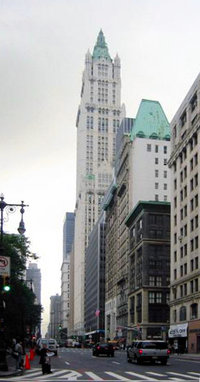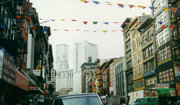Manhattan
|
|
- For other uses, see Manhattan (disambiguation).
Missing image Nyc-manhattan-skyline.jpg Lower Manhattan skyline (June 2003) |
 Woolworth Building, looking south along Broadway |
Missing image Manhattan_1942.jpg Aerial view of the tip of Manhattan looking like a miniature city, ca. 1942. |
 Chinatown in Manhattan, 1995. |
Manhattan is an island bordering the lower Hudson River. It is one of the five boroughs that comprise the City of New York. The borough is coterminous with New York County and includes the Island of Manhattan, as well as several other smaller islands and a small portion of the mainland (see geography). As of 2000, the population comprised 1,537,195 people, but the county is the smallest in the state of New York based on area.
| Contents |
Geography
New York County and the Borough of Manhattan are coextensive. As a part of New York City, New York County contains no other political subdivisions. It occupies the whole of Manhattan Island, surrounded by the East River, the Harlem River, and the Hudson River. It also includes some smaller islands, including Roosevelt Island (formerly Welfare Island, and even earlier Blackwell's Island), U Thant Island (officially known as Belmont Island), and a small portion of the North American mainland (Marble Hill) contiguous with The Bronx. Marble Hill was originally part of Manhattan Island; but the Harlem River Ship Canal, dug in the late 19th century to improve navigation on the Harlem River, separated it from the remainder of Manhattan, and eventually the part of the original Harlem River channel separating Marble Hill from the Bronx was filled in.
Manhattan Island is 21.5 km (13 miles) long and 3.7 km (2.3 miles) wide (at its widest point).
According to the United States Census Bureau, New York County (the Borough of Manhattan) has a total area of 87.5 km² (33.8 mi²). 59.5 km² (23.0 mi²) of it is land and 28.0 km² (10.8 mi²) of it is water. The total area is 32.01% water.
Manhattan is connected by bridges and tunnels to New Jersey to the west, and three New York City boroughs: the Bronx to the northeast and Brooklyn and Queens on Long Island to the east and south. Its only direct connection with the fifth New York City borough is the Staten Island Ferry, whose terminal is at Battery Park at its southern tip.
On May 28 and July 12 the sunrise and sunset are aligned with the street gridlines, so that the sun is visible at the horizon from street level.
See also
Manhattan landmarks
The Empire State Building, the theater district around Broadway, New York University, Columbia University, the financial center around Wall Street, Lincoln Center for the Performing Arts, Harlem, the American Museum of Natural History, Chinatown, and Central Park are all located on this densely populated island. (See also New York City.) The phrase "a New York minute" refers to the extremely rapid pace of living in Manhattan.
East Side and West Side
Fifth Avenue bisects Manhattan Island, dividing it into the East and West Sides. These east-west designations are used in latitudinal (east-west) streets (e.g. East 27th Street, West Houston Street). The Manhattan numbering system extends into the western Bronx, using Jerome Avenue as the east-west divider.
Uptown and downtown
In Manhattan, uptown means north and downtown means south, either in direction of motion or in relative location. For example, an uptown train means a subway train heading north, while a restaurant located three blocks downtown would be three city blocks south of the person who is speaking. North of Houston Street, nearly all east-west streets use numeric designations - which increase from south to north (reflecting the city's original growth in that direction). The terms uptown and downtown are most often used in the relative sense of north and south; however, uptown can also refer to the northern part of Manhattan (above 59th Street) and downtown to the southern part (below 23rd Street or 14th Street). The area in the middle, between 23rd and 59th Streets, is Midtown.
This usage differs from that of most American cities, where downtown refers to the central business district. Manhattan has two central business districts, namely the Financial District downtown and the newer business district in Midtown.
Within "downtown" is Lower Manhattan, a neighborhood defined as everything approximately south of Barclay Street and the Brooklyn Bridge; it is perhaps one of the most well-known parts of the city, home to City Hall, Wall Street, the South Street Seaport, the site of the World Trade Center, as well as a number of other significant landmarks.
The northernmost area of "uptown" is Upper Manhattan, encompassing the neighborhoods of Washington Heights and Inwood, and often Harlem. A less famous and hectic area, and given the distance from Midtown, Upper Manhattan is often thought of as an outer borough, given the similarities the region has to the adjacent western section of the South Bronx. In fact, Manhattan stretches so far northward from Midtown that some in the southern parts of Manhattan jokingly refer to the Inwood neighborhood as "Upstate Manhattan," "Arctic Manhattan," or "NoFair" (short for "North of Fairway," Fairway being a popular supermarket at 132nd St. and the Hudson River).
Traditionally, many New Yorkers have used the phrase The City when referring only to Manhattan, while referring to the other four boroughs as "outer boroughs". These terms are becoming less common, however, as more transplants from Manhattan continue to move into the other boroughs.
Manhattan neighborhoods
Manhattan is politically divided in 12 Community Boards :
- 1 : Tribeca and Lower Manhattan
- 2 : Greenwich Village, West Village, NoHo, SoHo, Lower East Side, Chinatown, Little Italy
- 3 : Tompkins Square, East Village, Lower East Side, Chinatown, Two Bridges
- 4 : Clinton, Chelsea
- 5 : Midtown
- 6 : Stuyvesant Town, Tudor City, Turtle Bay, Peter Cooper Village, Murray Hill, Gramercy Park, Kips Bay, Sutton Place
- 7 : Manhattan Valley, Upper West Side, and Lincoln Square
- 8 : Upper East Side, LenoxHill, Yorkville, and Roosevelt Island
- 9 : Hamilton Heights, Manhattanville, and Morningside Heights
- 10 : Harlem and Polo Grounds
- 11 : East Harlem and Harlem
- 12 : Inwood and Washington Heights
As with all large cities, Manhattan consists of many distinct neighborhoods, each with its own character.
See List of Manhattan neighborhoods
History
The name Manhattan ("hilly island" or "place of intoxication") is from the Algonquian languages of the earliest known inhabitants of the area. Legend has it that the island was purchased from the natives for $24 in beads and other such trinkets. The island was settled by the Dutch in 1624. (See New Amsterdam; see also History of New York City.)
New York County is named in honor of the Duke of York, later to become the Catholic James II of England, after whom the City and State of New York were also named. New York County was an original county of New York State, one of twelve created in 1683. At the time of creation of New York County, it was coextensive with Manhattan Island, and occupied the same area which it occupies today. In 1873, the western portion of the present Bronx County was transferred to New York County, and in 1895 the remainder of the present Bronx County was transferred to New York County. In 1898, when New York City was constituted as five boroughs, the separate boroughs of Manhattan and of the Bronx were formed, though both remained within the single County of New York. In 1914, those parts of the then New York County which had been annexed from Westchester County were constituted the new Bronx County, and New York County was reduced again to its present boundaries.
Law and government
Like the other counties which are contained within New York City, there is no county government, but county courts and some others such as the district attorney (public prosecutor) do exist. Each borough within New York City elects a borough president, but the office no longer carries any significant powers. (See New York City.)
Manhattan is officially designated as the county seat of New York County.Template:GR This is meaningless for all practical purposes because there are no other towns or cities in New York County, which is wholly contained within the City of New York.
Demographics
New York County is the most densely populated state county in the United States.
As of the censusTemplate:GR of 2000, there are 1,537,195 people, 738,644 households, and 302,105 families residing in the county. The population density is 25,849.9/km² (66,940.1/mi²). There are 798,144 housing units at an average density of 13,421.8/km² (34,756.7/mi²). The racial makeup of the county is 54.36% White, 17.39% Black or African American, 0.50% Native American, 9.40% Asian, 0.07% Pacific Islander, 14.14% other races, and 4.14% from two or more races. 27.18% of the population are Hispanic or Latino of any race. 45.8% of the population are Whites, not of Hispanic origins.
A partial list of the specific European ancestry claimed by Manhattan residents is as follows (2000):
- Irish : 7.48%
- Italian : 7.10%
- German : 6.63%
- English : 5.43%
According to an estimation by the Census Bureau, the population of New York county increased to 1,564,798 in 2003.
Lower Manhattan (ie Manhattan south of Houston street) has a sharply different population than the rest of the borough. Indeed, to the census of 2000, the neighborhood was 41 percent Asian, 32 percent non-Hispanic white, 19 percent Hispanic and 6 percent black, and 43 percent of the inhabitants were immigrants. This can be explained by the demographic weight of Chinatown, which counts for 55% of the population of Lower Manhattan.
There are 738,644 households out of which 17.1% have children under the age of 18 living with them, 25.2% are married couples living together, 12.6% have a female householder with no husband present, and 59.1% are non-families. 48.0% of all households are made up of individuals and 10.9% have someone living alone who is 65 years of age or older. The average household size is 2.00 and the average family size is 2.99.
In the county the population is spread out with 16.8% under the age of 18, 10.2% from 18 to 24, 38.3% from 25 to 44, 22.6% from 45 to 64, and 12.2% who are 65 years of age or older. The median age is 36 years. For every 100 females there are 90.3 males. For every 100 females age 18 and over, there are 87.9 males.
The median income for a household in the county is $47,030, and the median income for a family is $50,229. Males have a median income of $51,856 versus $45,712 for females. The per capita income for the county is $42,922. 20.0% of the population and 17.6% of families are below the poverty line. Out of the total population, 31.8% of those under the age of 18 and 18.9% of those 65 and older are living below the poverty line.
External links
- Randall's Lost New York City (http://www.lostnewyorkcity.com/)
- Letter of 1626 stating that Manhattan Island had been purchased for the value of 60 guilders (PD) (http://teachpol.tcnj.edu/amer_pol_hist/fi/00000002.htm)
- Map of Mannados or Manhattan in 1661 (PD) (http://teachpol.tcnj.edu/amer_pol_hist/fi/00000006.htm)
- NYC MTA Transit Bus Map of Manhattan (http://www.mta.nyc.ny.us/nyct/maps/manbus.pdf) (PDF file)
- The Story of Manhattan (http://www.gutenberg.net/dirs/1/3/8/4/13842/13842-h/13842-h.htm), by Charles Hemstreet. 1901 publication from Project Gutenberg
- Photographs of Manhattan (http://www.lodgephoto.com/galleries/usa/newyork/)
Maps, Streets, and Neighborhoods
- CitiDex: New York Maps Index (http://www.citidex.com/map/)
- Avenues, streets of Manhattan (http://translate.google.com/translate?langpair=fr%7Cen&hl=en&prev=%2Flanguage_tools&u=http%3A%2F%2Fwww.insecula.com%2Fmusee%2FM0100.html/)
Template:Geolinks-US-cityscale
- Interactive Manhattan Map (http://www.hot-maps.de/north_america/usa/new_york/new_york/manhattan/homeen.html)
da:Manhattan (New York) de:Manhattan es:Manhattan eo:Manhatano fr:Manhattan he:מנהטן ga:Manhattan it:Manhattan la:Manhata nl:Manhattan no:Manhattan ja:マンハッタン区 pl:Manhattan sk:Manhattan sl:Manhattan fi:Manhattan sv:Manhattan zh:曼哈頓





